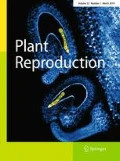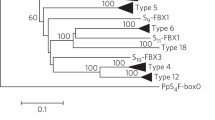Summary
We have identified three alleles of the S-locus controlling self-incompatibility and their associated pistil proteins in Petunia inflata, a species that displays monofactorial gametophytic self-incompatibility. These S-allele-associated proteins (S-proteins) are pistil specific, and their levels are developmentally regulated. The amino-terminal sequences determined for the three S-proteins are highly conserved and show considerable homology to those of S-proteins from Petunia hybrida, Nicotiana alata and Lycopersicon peruvianum, three other species of the Solanaceae that also exhibit gametophytic self-incompatibility. cDNA clones encoding the three S-proteins were isolated and sequenced. Comparison of their deduced amino acid sequences reveals an average homology of 75.6%, with conserved and variable residue interspersed throughout the protein. Of the 137 conserved residues, 53 are also conserved in the N. alata S-proteins studies so far; of the 64 variable residues, 29 were identified as hypervariable based on calculation of the Similarity Index. There is only one hypervariable region of significant length, and it consists of eight consecutive hypervariable residues. This region correspond approximately to the hypervariable region HV2 identified in N. alata S-proteins. Of the two classes of N. alata S-proteins previously identified, one class exhibits greater homology to the three P. inflata S-proteins reported here than to the other class of N. alata S-proteins.
Similar content being viewed by others
References
Anderson MA, Cornish EC, Mau S-E, Williams EG, Hoggart R, Atkinson A, Bonig I, Grego B, Simpson R, Roche PJ, Haley JD, Penschow JD, Niall HD, Tregear GW, Coghlan JP, Crawford RJ, Clarke AE (1986) Cloning of cDNA for a stylar glycoprotein associated with expression of self-incompatibility in Nicotiana alata. Nature 321:38–44
Anderson MA, McFadden GI, Bernatzky R, Atkinson A, Orpin T, Dedman H, Tregear G, Fernley R, Clarke AE (1989) Sequence variability of three alleles of the self-incompatibility gene of Nicotiana alata. Plant Cell 1:483–491
Brewbaker JL, Natarajan AT (1969) Centric fragments and pollen-part mutation of incompatibility alleles in Petunia. Genetics 45:699–704
Brewbaker JL, Shapiro N (1959) Homozygosity and the S-gene mutation. Nature 183:1209–1210
Cornish EC, Anderson MA, Clarke AE (1988) Molecular aspects of fertilization in flowering plants. Annu Rev Cell Biol 4:209–228
Dayhoff MO, Schwartz RM, Orcutt BC (1979) A model of evolutionary change in proteins. In: Dayhoff MO (ed) Atlas of protein sequence and structure vol 5, [Suppl 3]. National Biochemical Research Foundation, Washington DC, pp 345–352
Heijne G von (1985) Signal sequences: the limits of variation. J Mol Biol 184:99–105
Jahnen W, Batterham MP, Clarke AE, Moritz RL, Simpson RJ (1989) Identification, isolation, and N-terminal sequencing of style glycoproteins associated with self-incompatibility in Nicotiana alata. Plant Cell 1:493–499
Kamboj RK, Jackson JF (1986) Self-incompatibility alleles control a low molecular weight, basic protein in pistils of Petunia hybrida. Theor Appl Genet 71:815–819
Kheyr-Pour A, Bintrim SB, Ioerger TR, Remy R, Hammond SA, Kao T-H (1990) Sequence diversity of pistil S-proteins associated with game to phytic self-incompatibility in Nicotiana alata. Sex Plant Reprod 3:88–97
Eaemmli UK (1970) Cleavage of structural proteins during the assembly of the head of bacteriophage T4. Nature 227:680–685
Martin W, Gierl A, Saedler H (1989) Molecular evidence for pre-Cretaceous angiosperm origins. Nature 339:46–48
Matsudaira P (1987) Sequence from picomole quantities of proteins electroblotted onto polyvinylidene difluoride membranes. J Biol Chem 262:10035–10038
Mau S-E, Williams EG, Atkinson A, Anderson MA, Cornish EC, Grego B, Simpson RJ, Kheyr-Pour A, Clarke AE (1986) Style proteins of a wild tomato (Lycopersicon peruvianum) associated with expression of self-incompatibility. Planta 169:184–191
Nasrallah JB, Nasrallah ME (1984) Electrophoretic heterogeneity exhibited by the S-allele specific glycoproteins of Brassica. Experientia 40:279–281
Nasrallah JB, Kao T-H, Chen C-H, Goldberg ME, Nasrallah ME (1987) Amino acid sequence of glycoproteins encoded by three alleles of the S-locus of Brassica oleracea. Nature 326:617–619
Nettancourt D de (1977) Incompatibility in angiosperms. (Monographs on theoretical and applied genetics, vol 3) Springer, Berlin Heidelberg New York
Sink KC (ed) (1984) Petunia. (Monographs on theoretical and applied genetics, vol 9) Springer, Berlin Heidelberg New York
Author information
Authors and Affiliations
Rights and permissions
About this article
Cite this article
Ai, Y., Singh, A., Coleman, C.E. et al. Self-incompatibility in Petunia inflata: isolation and characterization of cDNAs encoding three S-allele-associated proteins. Sexual Plant Reprod 3, 130–138 (1990). https://doi.org/10.1007/BF00198857
Issue Date:
DOI: https://doi.org/10.1007/BF00198857




